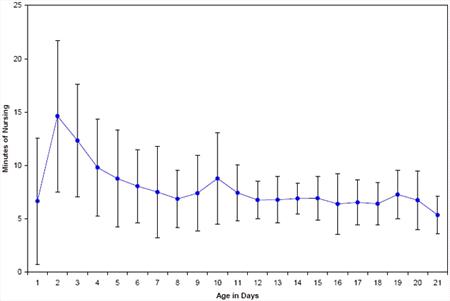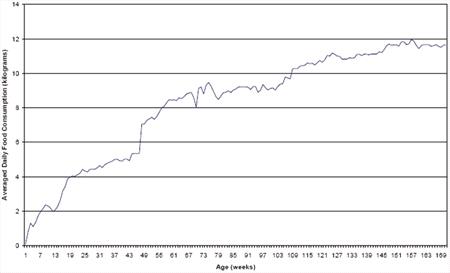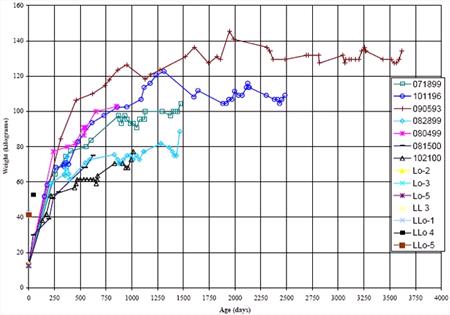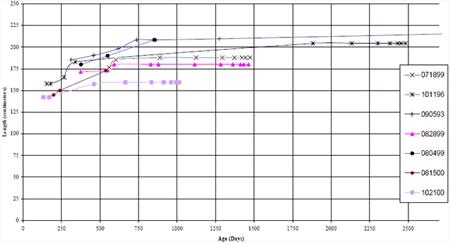Abstract
An abstract entitled, Growth and development of a Pacific white-sided dolphin (Lagenorhynchus obliquidens) (Dalton, Robeck, and Young) was presented at the 26th International Association for Aquatic Animal Medicine conference in 1995. Since then, SeaWorld San Antonio (SWSA), San Antonio, Texas, has had 9 more Pacific whitesided dolphin (lag) calves that can be added to that data. This will help provide general references regarding age at sexual maturity, parturition, nursing, body length and weight, and food intake compared to age for those dealing with this species.
Nine of the calves born at SWSA were conceived through a natural breeding program and one was conceived via artificial insemination (AI). The calf conceived by AI was delivered 367 days post insemination thus strengthening the belief that gestation in lags is 12 months. Table 1 provides information on parturition and calf size. Figure 1 illustrates average nursing times with standard deviation for ten calves for the first 21 days after birth.
A stillborn calf, 081496, was extremely large compared to all previous calves with known birth weights and lengths and that probably complicated delivery and contributed to its death. This animal was 17 kg, 3.5 kg heavier and 107.5 cm, 10 cm longer than the previous largest documented size of a lag calf at birth. Four hours after flukes were observed, 30 units of oxytocin was administered to the mother intravenously at 2301 hrs and was given again intramuscularly at 2353 hrs. The calf was expelled at 0103 hrs, 6 hours after flukes were observed and 1 hour and 10 minutes after the last injection of oxytocin. Asphyxiation was the cause of death due to the umbilical cord being crushed while the calf was in the birth canal.
Parturition and Size Observations
Table 1. Events observed during parturition and calf size. Observations are in hours and minutes. Girth is axillary girth.
|
Animal |
Flukes to birth |
Birth to placenta |
Birth to nursing |
Calf size at age in days |
|
090593 |
3:48 |
19:27 |
14:02 |
86 kg, 185 cm length, & 109 cm girth @ 310 days |
|
Lo-2 |
1:33 |
13:30 |
Still-born
term calf |
14 kg, 97 cm length, & 50 cm girth at birth |
|
Lo-3 |
Not recorded |
Not recorded |
Not recorded |
12 kg, 91 cm length, & 53 cm girth at 2 days |
|
Lo-4 |
Not recorded |
6:30 |
Not recorded |
116 cm length, & 73 cm girth at 49 days |
|
Lo-5 |
Not recorded |
Not recorded |
Not recorded |
13 kg, 91 cm in length, & 53 cm in girth at birth |
|
081496 |
5:10 |
Not recorded |
Still-born term
calf at 0103 hrs. |
17 kg & 109 cm |
|
101196 |
1:00 |
6:33 |
1:10 |
52 kg & 163 cm at 152 days |
|
071899 |
0:20 from 1st observation |
Not recorded |
8:50 |
65 kg at 255 days |
|
080499 |
1:53 |
7:41 |
2:11 |
84 cm at birth |
|
082899 |
0.20 |
6:21 |
1:10 |
59 kg at 186 days |
|
081500 |
Not recorded |
8:12 |
11:32 |
30 kg at 44 days |
|
102100 |
Not observed |
8:28 (approx
due to not
seeing the birth) |
8:30 |
38 kg & 142 cm at 131 days |
|
090803 |
0.53 |
6:26 |
2:0 |
81 cm at 2 days |
|
091103 |
1:25 |
6:24 |
1:18 |
42 kg & 140 cm at 53 days |
All calves were delivered flukes first, i.e., longitudinal, posterior presentation in a dorso-sacral position.
Click on the image to see a larger view.
| Figure 1. Lag nursing. | 
|
|
| |
The observations in figure 1 were influenced by weather, particularly sun and wind, and by the location of the calf. If the calf was in a pool with underwater viewing, the observations were much more accurate than when in a pool without underwater viewing. The data must be combined with observations of the physical condition of the calf and are of value for trends. N = 9.
Click on the image to see a larger view.
| Figure 2. Averaged daily food consumption vs. age in Pacific white-sided dolphins. | 
|
|
| |
Figure 2 illustrates the average food consumption starting with the first day a calf was observed to actually eat a fish. Total consumption varied due to normal base changes, caloric content of the fish, and health of the animal. Social structure also affected caloric intake. Diet consisted of 18% herring and 82% caplin estimated at 1,980 Kcals and 880 Kcals respectively. N = 9.
Click on the image to see a larger view.
| Figure 3. Weight vs. age in Pacific white-sided calves. | 
|
|
| |
Figure 3 compares weight to age. The initial weight for these animals was assumed to be the average of the other calves with known weights between birth and two days of age.
Click on the image to see a larger view.
| Figure 4. Length vs. age in Pacific white-sided calves. | 
|
|
| |
Figure 4 compares length to age. The length trends observed were gradual inclines followed by a steady plateau-like effect that appeared at maturity between 18 to 24 months of age.
From the limited data available on Pacific white-sided dolphin calves, it appears that the average birth weight is between 12 and 14 kilograms, the birth length is very near 91 centimeters, and adult size is reached within two years. Based on data collected at SWSA, adult weight is 82 kg to 161 kg and adult length ranges from 1.72 meters to 2.26 meters. Sexual maturity may be reached as early as 2 years 10 months as illustrated by one of our females giving birth to a healthy calf at 3 years and 10 months of age. The caloric intake averaged 152 Kcals/kg on animals less than 2 years of age.
Acknowledgments
The authors are grateful to the Animal Care and Animal Training staffs for all the time and effort put forth to collect the data presented. We also want to thank Megan Getz for her technical assistance without which the graphs would not have been included.